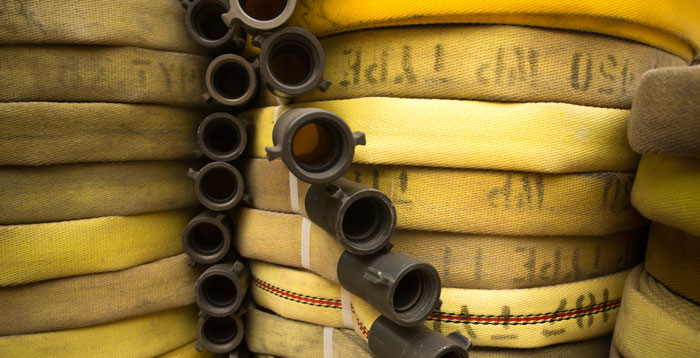Fire Curtains: A Sure Move Away From Asbestos!
The fabrics used in fire curtains and smoke curtains have come a long way since the dangers of asbestos-based products was recognised in the 1970s and 80s.
Newly developed materials are resulting in significant changes in the functional properties of fire protective fabrics used in fire and smoke curtains, enabling them to offer secondary functions, including that of providing insulation from a fire ultimately delaying the spread of fire to allow a building to be safely evacuated.
While standard fire curtains will hold back flames, there will still be heat transfer. Curtains using insulating coatings can now provide a thermal barrier, allowing people to evacuate from nearby areas, thus greatly extending the possible applications for these barriers.
Fire Protective Materials in Fire Curtains
The majority of fire protective fabrics are E-glass and fibreglass fabrics, which means the base cloth is essentially glass fibre filaments, wound together as a thread or yarn then woven in different weave patterns to give a variety of strengths and pliability making them perfect for easy to conceal fire curtains. These materials also will not decompose, shrink, stretch, fade or most importantly burn.
A basic glass fibre cloth can withstand temperatures up to a continuous working temperature of 600°C. However, glass fibre fabrics can also be woven with a metal thread to add strength, resistance to flex fatigue and to increase the overall temperature resistance up to 1000°C.
As a basic cloth, it is hard to work with and difficult to assemble and sew, therefore, coatings are used to make it more stable and hold the fabric together to make it easier to fabricate a final fire curtain product.
Different weaves can be teamed with different coatings to offer a variety of material properties suitable for a range of applications. This adaptability allows Coopers Fire to offer fabrics that are custom-made to suit particular applications or systems:
For example, when the need arose for fabrics to be concertina folded in fire curtains, Coopers Fire’s standard fabrics could not offer the pliability and durability required, so new combinations of weave and coating were investigated and a suitable solution developed.
Fire Curtains and Their Coatings
Initially, coatings used to stabilise and protect the base cloth were industry standard flame retardant synthetic rubbers and plastics. However, issues with high smoke density and the potential toxicity of the rubbers and plastics in the event of a fire led to the use of more advanced coatings, such as polyurethanes (PUs) and silicones.
PU coatings are now well-developed and relatively cheap. As a result, PU-coated fabrics are still in common use today and make up some 90% of fabrics used in smoke and fire curtains. However, it is the use of silicone coatings that is resulting in significant changes in the functional properties of fire protective fabrics. Silicone is non-toxic and offers exceptional resistance when subjected to very high temperatures, making a combination of a silicone coating on advanced glass fibre cloth the ultimate fire protective fabric for the foreseeable future.
As a result, of the success of silicone-coated fabrics, they are becoming more widely available. But, although the costs are coming down, they are more expensive adding approximately 30% onto the price of PU-coated fabrics.
Pure silicone elastomers are combined with a range of inorganic additives, such as ground minerals, making them more fire retardant and cost effective. A typical coating formulation would contain around 50% silicone, 30% calcium carbonate (chalk) and 20% other inorganic additives. The use of additives not only improves the coating’s fire retardant properties but also reduces tackiness, ensuring that curtains will unroll as needed.
Silicone elastomer coated fabrics are now used extensively both internally and externally. The latest materials have also been developed as intumescent fire barriers, offering a thermally insulating zone.
Fire Curtains and Testing
To ensure FPFs used today satisfies the latest standards it is essential that fabrics are tested individually and as part of the completed product for which it may be intended such as in a deployable, automatic fire curtain.
In the UK, fire curtains must meet the requirements of BS 476. To pass the test fabrics must not show any sign of flaming at any point during the test.
Coopers Fire curtains and smoke and fire curtains have been extensively tested and offer proven and reliable fire protection. In particular, the company’s EvacU8® and FIREMASTER® A1 non-combustible fabrics have obtained a Euroclass A1 rating, highlighting that modern fire protective fabrics, when used in fire curtain designs, can offer innovative solutions for architects; they design the buildings of the future.
For further information on Coopers Fire’s range of vertical and horizontal smoke and fire curtains please visit our website.


